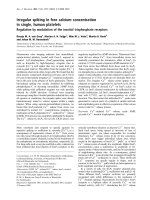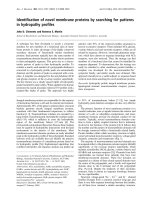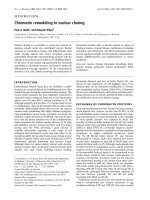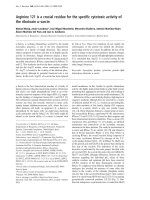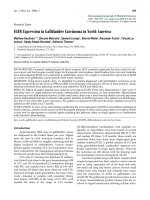Báo cáo y học: "Arginine vasopressin in septic shock: supplement or substitute for norepinephrine" pot
Bạn đang xem bản rút gọn của tài liệu. Xem và tải ngay bản đầy đủ của tài liệu tại đây (44.08 KB, 2 trang )
Available online />Page 1 of 2
(page number not for citation purposes)
Abstract
In the current issue of Critical Care, Simon and coworkers
investigated the effects of first-line arginine vasopressin (AVP) on
organ function and systemic metabolism compared with nor-
epinephrine in a pig model of fecal peritonitis. AVP was titrated
according to the mean arterial pressure suggesting a vasopressor
rather than a hormone replacement therapy. The study provides
some evidence for the safety of this therapeutic approach. It needs
to be determined whether AVP is most beneficial as a constant
low-dose infusion to supplement norepinephrine or in higher doses
than currently recommended to substitute norepinephrine. In
addition, future studies are warranted to evaluate whether a first-
line therapy of AVP is superior to a last-resort administration.
In the current issue of Critical Care, Simon and coworkers
carefully investigated the effects of arginine vasopressin
(AVP) on myocardial, hepatic and renal function as well as on
systemic metabolism compared with norepinephrine in a pig
model of fecal peritonitis [1]. Both compounds were titrated
to keep the mean arterial pressure (MAP) at baseline values.
Maximum doses were limited to 5 ng/kg/min for AVP (equiva-
lent to 0.14 IU/min in a 70 kg patient) and to norepinephrine
doses causing a heart rate ≥160 beats/min. AVP reduced
systolic myocardial contractility, cardiac output, heart rate
and troponin I levels compared with norepinephrine. In
addition, kidney and liver injury were attenuated and the rate
of direct aerobic glucose oxidation was increased in AVP-
treated animals. The authors concluded that, with respect to
myocardial, renal and liver function, AVP seems to represent
a safe therapeutic approach in well-resuscitated septic
shock.
Although exclusively focused on by the authors, this elaborate
study does not solely extend our knowledge from previous
experimental studies [2,3] and clinical trials [4,5] about the
safety of AVP in septic shock. The study protocol rather
reveals some interesting differences compared with recent
experiments. Based on the relative AVP deficiency in septic
shock [6], AVP is prevailingly administered as a continuous
low-dose infusion (0.02 to 0.04 IU/min). This so-called
hormone replacement therapy [7] usually leads to AVP plasma
levels of about 100 pmol/ml [6,8]. In contrast, the titration of
AVP according to MAP in the present study implies the
primary intention of AVP as a vasopressor [9,10]. Accordingly,
higher AVP doses are necessary to achieve the individual
threshold values. In this context, a retrospective, controlled
study in 78 patients with vasodilatory shock reported that
higher doses of AVP (0.067 vs. 0.033 IU/min) were more
efficient than and as safe as the low-dose regimen [11].
The maximum dose of AVP administered in the present study
was almost five times higher than in the Vasopressin And
Septic Shock Trial (0.14 vs. 0.03 IU/min) [8]. Whether this
dose corresponds to the calculated dose in humans,
however, remains unclear. Since lysine vasopressin and not
AVP represents the endogenous hormone in pigs, vaso-
pressin receptors might be less sensitive to exogenously
administered AVP than in humans. Besides the receptor
sensitivity, the AVP plasma levels would have been of
interest, because a differentiation between endogenous and
exogenous vasopressin might have been possible.
AVP was used as a sole first-line therapy representing a
substitute for, and not a supplement to, the standard treat-
ment with norepinephrine. Notably, in contrast to a recent
experimental study in ovine septic shock [2], AVP was not
only able to restore but also to maintain the MAP at baseline
values with minimal supplementation of norepinephrine at the
end of the 24-hour observation period (0.06 μg/kg/min). This
Commentary
Arginine vasopressin in septic shock: supplement or substitute
for norepinephrine?
Sebastian Rehberg
1,2
, Perenlei Enkhbaatar
1
and Daniel L Traber
1
1
Investigational Intensive Care Unit, Department of Anesthesiology, The University of Texas Medical Branch, 301 University Blvd, Galveston,
TX 77555, USA
2
Department of Anesthesiology and Intensive Care, University of Muenster, Albert-Schweitzer-Str. 33, 48149 Muenster, Germany
Corresponding author: Sebastian Rehberg,
Published: 14 August 2009 Critical Care 2009, 13:178 (doi:10.1186/cc7985)
This article is online at />© 2009 BioMed Central Ltd
See related research by Simon et al., />AVP = arginine vasopressin; MAP = mean arterial pressure.
Critical Care Vol 13 No 4 Rehberg et al.
Page 2 of 2
(page number not for citation purposes)
finding may be explained by the less severe septic shock at
the time of treatment initiation (drop in MAP of 10% in the
present study vs. 30% in the latter study) and is in line with
the results of a subgroup analysis from the Vasopressin And
Septic Shock Trial [8].
Unfortunately, the design of the present study does not allow a
fair comparison between both treatment strategies, because
AVP was supplemented with norepinephrine after the maxi-
mum dose was reached, while there was no AVP supple-
mentation in the norepinephrine group. In a randomized,
controlled, open-label trial in 23 patients with septic shock,
however, the first-line therapy of 0.04 to 0.20 U/min AVP
reduced norepinephrine requirements and improved renal
function and Sequential Organ Failure Assessment scores
compared with norepinephrine. Notably, only 36% of the
patients treated with AVP were supplemented with norepi-
nephrine [12].
Reviewing the current literature on this topic together with the
work of Simon and coworkers, the proposed treatment
strategy for AVP in septic shock (constant low-dose infusion
as a supplement to norepinephrine in catecholamine-resistant
shock) might not represent the optimal approach. A first-line
therapy, even in doses higher than currently recommended by
the guidelines of the Surviving Sepsis Campaign [13], might
be superior to a last-resort administration. At least, the present
study provides some evidence for the safety of this therapeutic
approach. In addition, a titration of AVP doses according to
the MAP might be more effective than a hormone replacement
therapy. Future studies are now needed to further investigate
the most beneficial dose regimen and time of treatment
initiation for AVP in septic shock.
Competing interests
The authors declare that they have no competing interests.
References
1. Simon F, Giudici R, Scheuerle A, Groger M, Asfar P, Vogt JA,
Wachter U, Ploner F, Georgieff M, Moller P, Laporte R, Raderma-
cher P, Calzia E, Hauser B: Comparison of cardiac, hepatic, and
renal effects of arginine vasopressin and noradrenaline
during porcine fecal peritonitis: a randomized controlled trial.
Crit Care 2009, 13:R113.
2. Rehberg S, Ertmer C, Kohler G, Spiegel HU, Morelli A, Lange M,
Moll K, Schlack K, Van Aken H, Su F, Vincent JL, Westphal M:
Role of arginine vasopressin and terlipressin as first-line
vasopressor agents in fulminant ovine septic shock. Intensive
Care Med 2009, 35:1286-1296.
3. Sun Q, Dimopoulos G, Nguyen DN, Tu Z, Nagy N, Hoang AD,
Rogiers P, De Backer D, Vincent JL: Low-dose vasopressin in
the treatment of septic shock in sheep. Am J Respir Crit Care
Med 2003, 168:481-486.
4. Dunser MW, Mayr AJ, Ulmer H, Knotzer H, Sumann G, Pajk W,
Friesenecker B, Hasibeder WR: Arginine vasopressin in
advanced vasodilatory shock: a prospective, randomized, con-
trolled study. Circulation 2003, 107:2313-2319.
5. Luckner G, Dunser MW, Jochberger S, Mayr VD, Wenzel V, Ulmer
H, Schmid S, Knotzer H, Pajk W, Hasibeder W, Mayr AJ, Friese-
necker B: Arginine vasopressin in 316 patients with advanced
vasodilatory shock. Crit Care Med 2005, 33:2659-2666.
6. Landry DW, Levin HR, Gallant EM, Ashton RC Jr, Seo S,
D’Alessandro D, Oz MC, Oliver JA: Vasopressin deficiency
contributes to the vasodilation of septic shock. Circulation
1997, 95:1122-1125.
7. Vincent JL: Endocrine support in the critically ill. Crit Care Med
2002, 30:702-703.
8. Russell J, Walley K, Singer J, Gordon A, Hébert P, Cooper D,
Holmes C, Mehta S, Granton J, Storms M, Cook DJ, Presneill JJ,
Ayers D: Vasopressin versus norepinephrine infusion in
patients with septic shock. N Engl J Med 2008, 358:877-887.
9. Klinzing S, Simon M, Reinhart K, Bredle DL, Meier-Hellmann A:
High-dose vasopressin is not superior to norepinephrine in
septic shock. Crit Care Med 2003, 31:2646-2650.
10. Westphal M, Freise H, Kehrel BE, Bone HG, Van Aken H, Sie-
lenkamper AW: Arginine vasopressin compromises gut
mucosal microcirculation in septic rats. Crit Care Med 2004,
32:194-200.
11. Luckner G, Mayr VD, Jochberger S, Wenzel V, Ulmer H,
Hasibeder WR, Dünser MW: Comparison of two dose regi-
mens of arginine vasopressin in advanced vasidilatory shock.
Crit Care Med 2007, 35:2280-2285.
12. Lauzier F, Levy B, Lamarre P, Lesur O: Vasopressin or norepi-
nephrine in early hyperdynamic septic shock: a randomized
clinical trial. Intensive Care Med 2006, 32:1782-1789.
13. Dellinger RP, Levy MM, Carlet JM, Bion J, Parker MM, Jaeschke R,
Reinhart K, Angus DC, Brun-Buisson C, Beale R, Calandra T,
Dhainaut JF, Gerlach H, Harvey M, Marini JJ, Marshall J, Ranieri M,
Ramsay G, Sevransky J, Thompson BT, Townsend S, Vender JS,
Zimmerman JL, Vincent JL: Surviving Sepsis Campaign: interna-
tional guidelines for management of severe sepsis and septic
shock: 2008. Crit Care Med 2008, 36:296-327.



